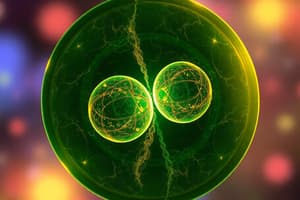Podcast
Questions and Answers
What is the result of parent cells undergoing mitosis?
What is the result of parent cells undergoing mitosis?
- One identical daughter cell
- Two non-identical daughter cells
- Two identical daughter cells (correct)
- Four identical daughter cells
What type of reproduction involves mitosis in single-celled organisms?
What type of reproduction involves mitosis in single-celled organisms?
- Genetic mutation
- Binary fission
- Sexual reproduction
- Asexual reproduction (correct)
What is the purpose of meiosis in organisms that reproduce sexually?
What is the purpose of meiosis in organisms that reproduce sexually?
- To repair damaged DNA
- To produce identical daughter cells
- To produce sex cells with half the number of chromosomes (correct)
- To increase genetic variation
What is the primary difference between mitosis and meiosis?
What is the primary difference between mitosis and meiosis?
What is the purpose of the animation in the simulation?
What is the purpose of the animation in the simulation?
What should you do after completing the Mitosis portion of the simulation?
What should you do after completing the Mitosis portion of the simulation?
When will you complete the rest of the simulation?
When will you complete the rest of the simulation?
Study Notes
Cell Reproduction
- Mitosis produces two identical daughter cells with the same number of chromosomes as the parent cell.
- This process occurs in multicellular organisms, such as humans, to produce new cells.
- Single-celled organisms also use mitosis to asexually reproduce.
Meiosis
- Meiosis produces sex cells with half the number of chromosomes found in other cells.
- This process is used in sexually reproducing organisms.
Simulation Instructions
- Observe the animations and films of mitosis and meiosis to understand the processes.
- Record observations on the student sheet during each phase.
- Use the orange arrows to navigate through the animation and view specific phases.
- Complete the Mitosis portion of the simulation before proceeding to Activity 3, "Mitosis and Asexual Reproduction."
- Complete the Meiosis portion of the simulation during Activity 13, "Meiosis and Sexual Reproduction."
Studying That Suits You
Use AI to generate personalized quizzes and flashcards to suit your learning preferences.
Description
Understand the processes of cell division, including mitosis and meiosis, and how they occur in multicellular and single-celled organisms. Identify the phases of each process and their role in cell reproduction.





